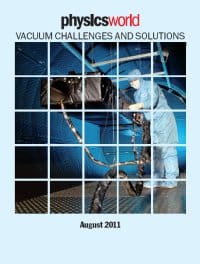
By Hamish Johnston
While vacuum technology is common place in the research labs of wealthy countries, scientists in developing nations often lack access to the most basic surface-science facilities.
In Physics World‘s latest Vacuum Challenges and Solutions supplement, J J Pireaux explains how the international vacuum association IUVSTA is reaching out to developing countries. In an exclusive interview, IUVSTA’s president explains what the society is doing to attract new members from developing nations. Another key part of IUVSTA’s strategy is its World Transfer Program, which will soon be offering grants to early-career scientists so they can work in another lab for a short period of time.
Moving on to countries that have developed rapidly into top-tier economies, the supplement also has an article by Matthias Wiemer and Wannong Eckhardt that addresses the challenges of operating in the “BRIC” countries. According to Wiemer and Eckhardt, Pfeiffer Vacuum has seen a significant increase in demand for vacuum equipment in Brazil, Russia, India and China – as well as other countries in Asia. Writing in the supplement, the pair argue that simply shipping vacuum kit to BRIC nations is not enough. Instead firms must create “well-established service networks close to customers”.
Going from the “second world” to “out of this world”, Giles Case of the Rutherford Appleton Laboratory explores how vacuum systems are used to test satellite components – and even entire satellites – before they are sent into space.
The supplement also allowed me to put my vacuum experience to good use in researching and writing an article about the reuse and recycling of vacuum equipment. I interviewed people from businesses ranging from industry giant Oerlikon Leybold Vacuum to the four-person outfit PSP Vacuum – and discovered that the used-equipment business keeps on growing.
You can download a free PDF of the supplement here.



